Camas Flowers & Roots
Camas flowers, yes these are the plants the Camas
Prairie is named for
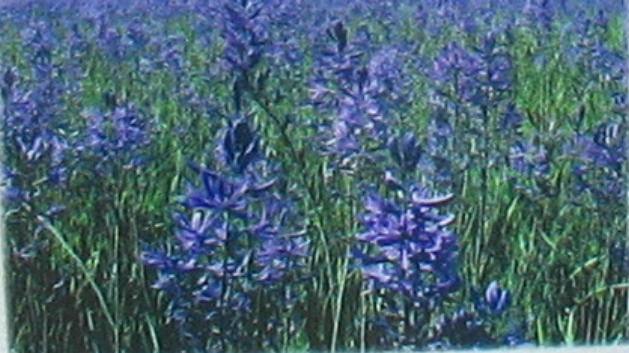
Camas, the plant the Camas
Prairie was named for are not nearly what they used to be.
Camas bulbs, which grow about 4 to 6 inches beneath the ground, are
harvested in a centuries-old tradition by Nez
Perce women in August and early September. The bulbs are then
painstakingly prepared and stored.
As you can imagine the once abundant camas fields have been destroyed
by ranching and farming operations.
Sign welcoming you to the Camas
Prairie of western Idaho
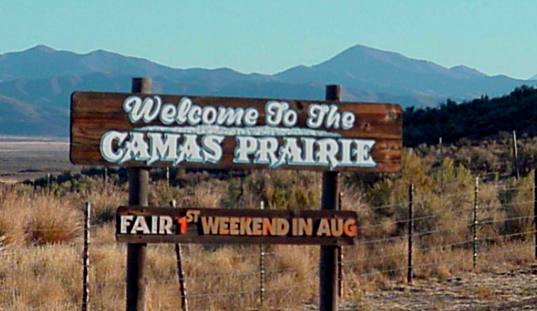
Camas bulbs or roots that were a staple in the Nez
Perce diet
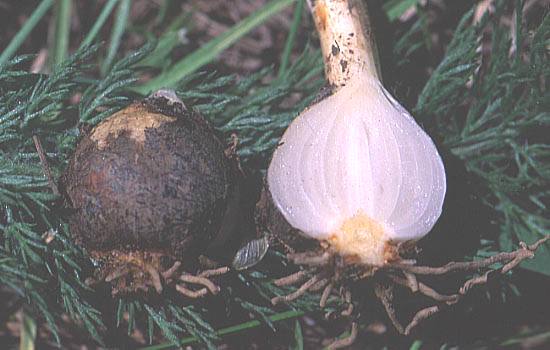
The first contact white man had with camas bulbs or roots was from
Lewis and Clark.
On the trip west the Corps of Discovery about starved to death crossing
the Bitterroot Mountains. When they emerged from the Bitterroot Mountains
they were near starvation. The Nez
Perce fed them camas bulbs made into a bread.
Camas bulbs or roots that the Nez
Perce used as a staple in their diet
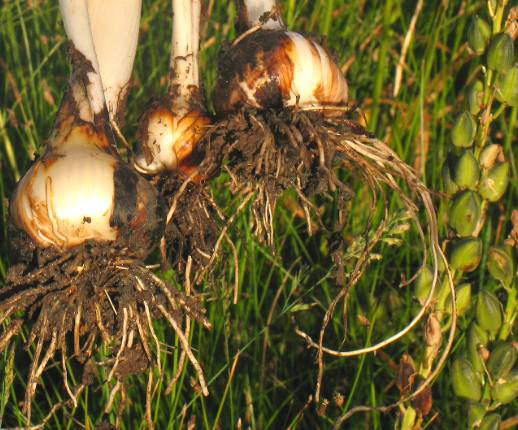
Camas harvesting required planning because the bulbs reach maximum
size and highest food value, and are best for storage, only at a specific
time--after the flowers have withered.
Trips to distant meadows by the Nez
Perce required careful timing to meet this condition.
Intimate knowledge of detailed plant features is another element of
the Nez
Perce system. In the case of camas, this is especially critical,
because “death camas,” a relative of edible camas, can occur
in the same habitat.
The two are easy to tell apart by flower color--edible camas is blue,
the other creamy white.
But since harvest occurs after flowering is over, this color cue
would not be present.
Camas bulbs or roots that the Nez
Perce used as a staple in their diet
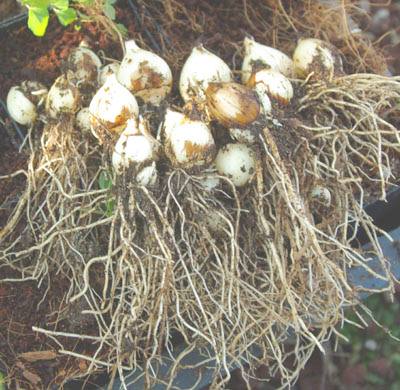
Possibly the Nez
Perce scheduled trips to the meadows in the Camas
Prairie and Weippe
Prairie during flowering to dig out the toxic species; or
perhaps gatherers were able to differentiate the plants by their bulbs.
Camas bulbs were cooked to improve taste and food value. A carbohydrate
in camas called inulin is difficult to digest, but after cooking for
up to two days in a carefully tended pit oven, the inulin converts
to fructose, which is more easily digested and tastes sweet.
Baked camas can be eaten right away. For long-term storage, though,
the cooked bulbs were sun-dried, mashed, shaped into a flat loaf,
and baked again.
Now, back to Lewis & Clark and the Corps of Discovery.
Trudging out of the Bitterroot Mountains in September of 1805, the
explorers entered the home of the Nez
Perce. Recognizing the desperate state of the travelers, the
Nez
Perce offered food: berries, dried buffalo and salmon, and
a bread prepared from camas root - all staples of the Nez Perce diet.
Clark and the others gorged on the bread calling it “excellent”,
“sweet”, “good and nourishing.” Not long after
this meal, however, the explorers became quite ill. Perhaps, with
empty stomachs and unaccustomed to this new food, the camas had disagreed
with them.
Camas lily in bloom
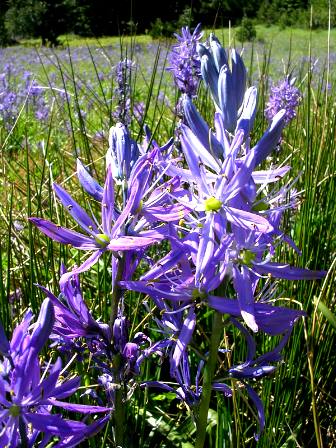
More about the "camas lily" from the Corps of Discovery:
By the following summer, as they began their journey home, the men
of the Expedition, like Lewis, could appreciate the beauty of the
prairie that sat at the base of daunting mountains. Remembering his
mission to document the plants and people of the west, Lewis took
the time to write more than 1500 words about the Camas plant. He also
described the Nez
Perce technique for collecting and preparing the roots of
the plant.
To the Nez
Perce, or Nimiipuu, the camas plant has a deeper meaning.
For thousands of years, the Nez
Perce made their home near Weippe
Prairie and relied on the plant that once grew in abundance
there. Today, the descendents of the Nez
Perce who helped Lewis and Clark still harvest and roast the
camas plant. With much of the Nez
Perce homeland now used for agriculture or encroached upon
by forests the sea of blue described by Meriwether Lewis is increasingly
difficult to find. Nonetheless, tribal members, in partnership with
researchers and biologists, work to preserve and expand this historic
landscape.
Field of camas lily flowers like described in the journals of the
Corps of Discovery
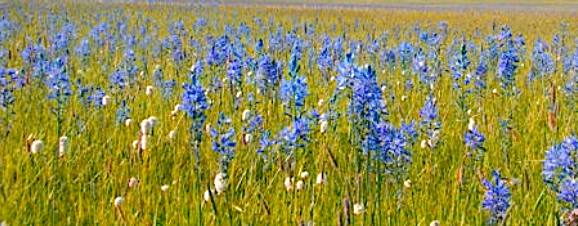
Fields like this where the camas lily used to flourish are now covered
in peas and canola, both in the Wepi
Prarie and Camas
Prarie.
Camas lily bloom
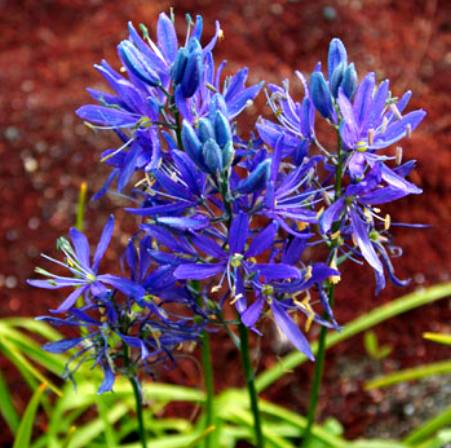
Each fall Nez
Perce families traveled to the large camas meadows near present-day
Weippe,
Moscow or Grangeville
in the Camas
Prairie where the onion-shaped bulbs grew thickly. Women used
digging tools and were able to harvest over 50 pounds a day. In a
few days, enough could be gathered for a winter’s food supply.
Women held rights to family camas patches, carried out the harvesting
and baking, and gained the right to use surplus bulbs for trading.
Camas lilies in bloom
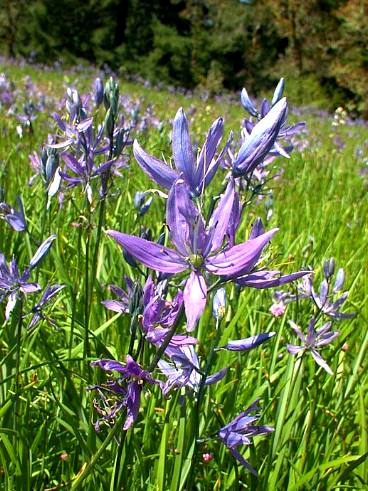
More information from the Corps of Discovery Journals:
At Weippe
that September, Clark wrote about the abundance of camas bulbs he
saw: "emence quantity of the quawmash or Pas-shi-co root gathered
& in piles about the plains." And the journals estimate that
there were more than 4,500 Nez
Perce. How could such large harvests of camas be sustained?
Early accounts of Native American subsistence apply terms like “hunter/gatherer.”
But today ethnobotonists and anthropologists describe the cultivation
and storage of important food plants as complex systems capable of
sustaining dependable annual supplies for large populations. The Nez
Perce system for camas is a good example.
To remain productive, camas meadows need to be open and sunny, free
of encroaching tree growth. Fire was used as a tool to accomplish
this. Camas bulbs themselves were tended, too. During harvest the
bulbs were sorted by size: large ones were collected but smaller bulbs
or bulblets were put back into the newly worked-up soil for next year.
The descriptions of native American practices in Lewis and Clark’s
journals are famous for their details and new information. But as
travelers on a schedule they may have missed important elements of
the Nez
Perce system for producing annual crops of big camas bulbs.
And, because camas cultivation was carried out "in the wild"
with neither row crops nor fences, it wouldn’t have matched the
explorers' mental image of domestic food production. This was a system
planned and carried out by women, whose horticultural skills were
not investigated by Lewis and Clark.
From what has been written it is fairly obvious that the Nez
Perce was much more evolved than would have been thought.
A relationship with the camas lily must have been in place, involving
both the practice of ceremonies to mark and give thanks for this important
food, and strict protocols about when to harvest and how much to take.
Mike & Joyce Hendrix

Mike
& Joyce Hendrix who we are
We hope you liked this page. If you do you might be interested in
some of our other Travel Adventures:
Mike & Joyce Hendrix's home page
Travel Adventures
by Year ** Travel Adventures
by State ** Plants ** Marine-Boats
** Geology ** Exciting
Drives ** Cute Signs
**
RV Subjects **
Miscellaneous
Subjects
We would love to hear from you......just put "info" in
the place of "FAKE" in this address: FAKE@travellogs.us
Until next time remember how good life is.










